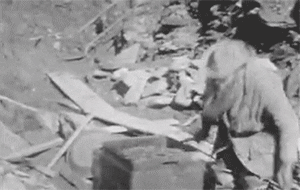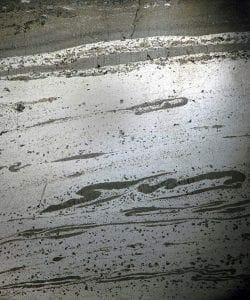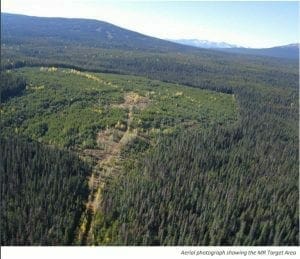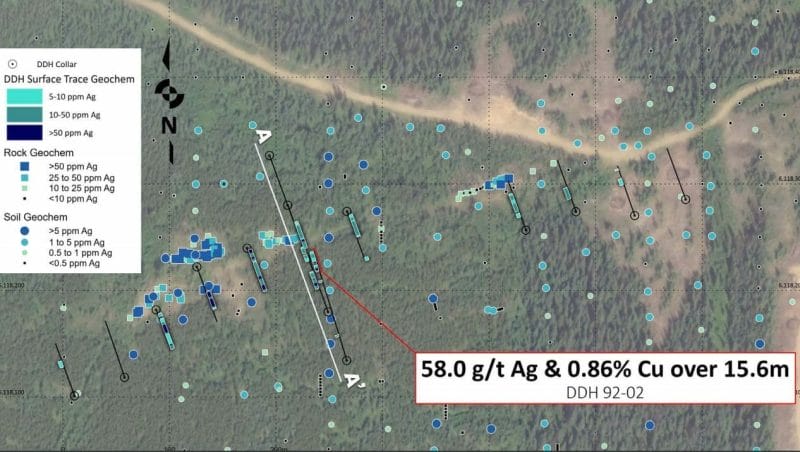If you’re one of those grey-haired fixed-income zimmer frame-wielding investor conference types who understands mining data and has been through more exploration paper than toilet paper, you can probably skip down to the halfway point of this article, because I aim to lay some layman talk on what is, to most people, a damn mystery.
How most investors see mining:
Step 1: Find ore.
Step 2: Get ore.
Step 3: Profit.
Step 1: Read many pages of geo reports.
Step 2: Claw eyes out in boredom.
Step 3: Drink self into self loathing frenzy, contemplate meth as a potential life choice, and promise never to do this again.
Well, not really.
There are terms in mining that, once you know them, make it a little easier to tell what’s a good thing and what isn’t. These terms are spoken in hushed, sometimes whiskey-soaked tones by old men with beards and dusty hats, but nobody else knows what they’re talking about.

They speak of things like grade, which is how much of a given ore is found in the drill holes, mixed in with other dirt, rock, and tree roots. The more ore, the merri-or (sorry).
Things like infrastructure, which are the things around a mine that make it easier to work, such as electricity, and roads, and people nearby who’ll work for you and know what they’re doing, and water, and an absence of snakes. It’d be nice to have an Arbys nearby so employees aren’t forced to kill their young for protein, and maybe a train line or a highway so they can get the rocks out without the use of canoes.
Another thing you want around is a resource estimate (AKA, an NI 43-101). When a company has one of those, it means smart people have deemed there to be actual minerals under the ground in an amount that is important. A Preliminary Economic Assessment (PEA) is another good thing, because it tells you what smart people have deemed to be the likely economic potential of the mine if it goes to production.
Look at us! We’re getting smarter. We’re experts on mining now.
But there’s one more phrase I want to teach you, before we start doing a jig and drinking out of a flask.
SEDIMENTARY DEPOSITS.
That’s right, Bieber. We’re talking the sex of Sed-X.
A sedimentary deposit, in layman’s terms, is when a rock is cracked open by a boatload of salty brines, and out of that punctured rock comes all the minerals that were inside. They then float to the bottom or a lake or ocean of river, and as the body of water dries up, they become exposed.
You love a good sed-x deposit, because instead of having to burrow into tonnes of rock and hope you’re going in the right direction to find a vein of ore, you can more or less pick the stuff up off the ground.
Or, more likely, peel away a few feet of soil to find it. Sure beats dynamite.
A porphyry deposit is different in that it comes from volcanic activity meeting water and cooling rapidly, and is sometimes trapped inside or beneath rock.
When folks hit the river with a gold pan and sift for gold nuggets, what they’re looking for is gold that has been caught by the water and tumbled down the river. Finding where that gold came from is every geologist’s dream.
In a Sed-X, the gold has already moved down river and stopped somewhere, sometimes in large numbers.
This photo, courtesy of Wikipedia, shows what it looks like in a cross section.
With a deposit that requires you dig deep shafts to get to veins of ore, or strip back enough earth to form a pit around where you think said veins will be, you require high grade to make such activities worthwhile. But a sed-x deposit is a swathe, and is thus far easier to locate.
In that case, a lower grade remains profitable.
And a high grade? Well, that’s a nice situation.
Lemme introduce you to Glacier Lake Resources (GLI.V), a little outfit that has a silver/copper project in north central BC, 55km northeast of Smithers and 300km northwest of Prince George.
It appears to be a sedimentary deposit, which is rare in the silver/copper business, at least up north.
The infrastructure? Solid.Transport by road, rail and water. All electricity needs covered. Workers nearby. And a landscape that’s not tough to penetrate. Because there’s already been logging on the property, the lumber crew have paid for roads etc.
The grade? There’s only been 1252 metres of drilling to this point, but 2.84 meters of that averaged 195.7 g/t silver (Ag) and 3.65 % copper (Cu) at a depth of 192.62m, which is hellaciously good. That’s a highlight however, and from data back in the 90’s which has not been verified recently, so it’s hard to bank on until there’s been a lot more drilling done.
There’s a drill program recently completed that adds another 1273 metres to that data, assays are
expected by the end of April 2018, but even that will be small time – they’re sitting on 207 square kilometers of land, otherwise figured as a 32km x 8-11km swathe. That, and sed-x deposits tend to be wide.
Downside: It’ll take some time to settle on targets and properly drill them.
Upside: It’ll take some time to settle on targets and learn how big this thing could be.
In situations like this, one of the first things a mineral explorer does is a ‘geochem’ run, where they test soil samples to see what shows up. If there’s gold around, for example, you might find a little gold speckage in the surrounding soil. If there’s copper, ditto.
Here’s the geochem map for GLI’s Silver Vista property:
Those dark blue splotches are interesting, and present GLI’s execs with information they can use to figure out future places to drop a drill. If you find a lot of traces of silver in one area, and can track back where water would have likely traveled past that spot, you give yourself a fighting chance of figuring out the origins, and perhaps a lot more shiny stuff.
And when you have 207 su kms of land, there’s a good chance those origins happened on your plot.
According to the company, on their nearby ‘Golden Vista’ patch, “Silver values in the soils are enriched and widespread, with more than 37 per cent of the soil samples returning plus one g/t Ag in the soils.”
Again, that’s not in the rock – that’s in the soil, just kickin’ about.
Of course, a lot of in the know folks would point to all this and say, “other companies have explored this land and never moved forward – why would Glacier Lake?”, and that’d be a fair question.
The easy answer is, it was held by a prospector who didn’t have the means to drill it for some time.
Equity Silver Mines (a division of Placer Dome) did the previous drilling on the land back in the early 90’s, but got distracted by other projects when Placer was acquired by Barrick Gold (ABX.T), which has a lot of projects going on and didn’t see value in an early stage silver/copper play.
It then bounced around a bit from Metal Mountain Resources (MMV.V) to Amarc Resources (AHR.V), who did extensive work in prep for a drill program before the resource market ground to a shuddering halt in 2012.
Last year, Jaxon Mining (JAX.V) made a nice run on the market and generated buzz with its exploration story, settling in with an $11m market cap. Jaxon is literally next door to the GLI patch. As it explores outwards, it may well come butted up against the border to GLI’s claims.
This is an early stage mining play and there’s every chance it will take some time to move forward. That’s kind of the bet, in the junior mining space; that your money is on a crew, and a land package, and in a sector that merits patience and will return a reward in good time because your people know what they’re doing.
This is a group that knows how to work a plot.
They’ve raised money, so there’s no risk of the electricity bill not being paid.
They’re in a sector, in silver, that has underperformed in relation to gold, which it has historically been tied to, but folks like me like getting in when the water is cold and the stock prices low.
The stock structure – that is, how many shows are out when warrants are cashed in and options are had, is 52m shares fully diluted, which leaves them plenty of room to use future shares to raise money without diluting the hell out of your holdings.
When I asked execs what their plans were – if they wanted to drill where they knew they’d find ore (lowering risk but lessening the potential size of the resource), or step out in a bigger way and try to show this is a monster resource, they said they’re going for the big show.
CEO Saff Dhillon said, “We’re convinced there’s a lot to be learned, so we’re going to step out in 200m to 400m intervals. Our people believe this is a potential one of a kind project and if we’re going to do the work, let’s not mess around.”
The risk on that is, if they miss on a few holes, it could hurt the stock. The upside is, if they hit on everything, the stock could fly.
So far, they’ve found silver and copper on every run they’ve done.
If you’ve never invested in precious metals before, it can be a little intimidating. In cannabis, you know when a company has a license they’ll grow some weed and probably sell some, but high valuations could make stock prices a little crazy. In blockchain, we know the technology will be mega useful and rule the financial world, but we don’t know how or through who.
In precious metals, you know there’s probably some ore down there waiting to get hoovered up, but you don’t know if the team you’re behind will be able to find it, or in enough numbers to warrant an actual mine.
But in all these instances, if you bet on strong management, and on sectors that have the potential for high growth, and you weigh expectations and focus on lowering your risks, there’s the potential for multiples to be had.
In this instance, the risk isn’t that no metals will be found, but that they’ll take too long to track, or the silver market will drop.
Neither of these are a concern for the long haul investor. And the long haul investor would be well advised to look at one other metric when considering resource opportunities: Sentiment.
Volume has been growing on GLI of late. Drill results are released soon. Take note.
GLI is up 7.7% in early trading.
— Chris Parry
FULL DISCLOSURE: Glacier Lake Resources paid a fee for our attention in this story.







